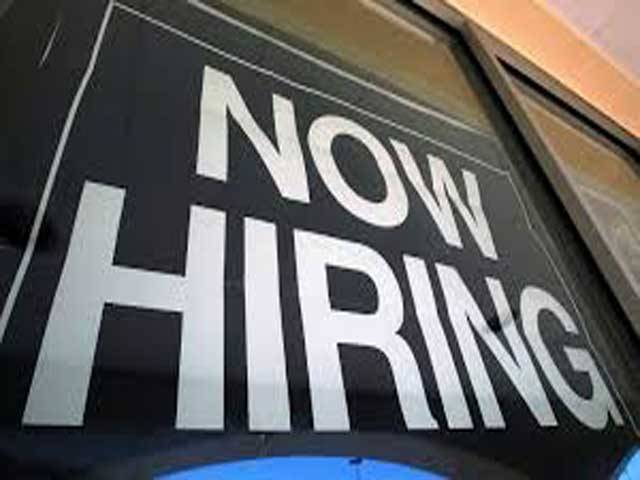WASHINGTON - US job growth slowed in December after surging in the prior month, but the pace of hiring is enough to keep the longest economic expansion in history on track despite a deepening downturn in a manufacturing sector stung by trade disputes.
The Labor Department’s closely watched monthly employment report on Friday also showed the jobless rate holding near a 50-year low of 3.5%. A broader measure of unemployment dropped to a record low last month, but wage gains ebbed. The mixed report will probably not change the Federal Reserve’s assessment that both the economy and monetary policy are in a “good place.”
“The report suggests a moderate pace of economic growth,” said Michael Feroli, an economist at JPMorgan in New York. “The Fed is comfortably on hold.”
Nonfarm payrolls increased by 145,000 jobs last month, with manufacturing shedding jobs after being boosted in November by the return to work of about 46,000 production workers at General Motors (GM.N) after a strike, the government’s survey of establishments showed. That was the smallest gain since May.
But milder-than-normal temperatures in December boosted hiring at construction sites, and employment at retailers surged last month. Some of the slowdown in overall job growth in December is likely due to seasonal volatility associated with a later-than-normal Thanksgiving Day. Economists polled by Reuters had forecast payrolls rising by 164,000 jobs in December.
“Today’s data also falls in line with a series of job growth decelerations that we’ve traditionally seen in years with calendar set-ups that involve a late Thanksgiving Day holiday, which often can lead to flattering November payroll data at the expense of December,” said Rick Rieder, global fixed income chief at BlackRock in New York.
Roughly 100,000 jobs per month are needed to keep up with growth in the working-age population. The economy added 14,000 fewer jobs in October and November than previously reported.
The final employment report of the decade showed the economy created 2.1 million jobs in 2019, the least since 2011 and down from 2.7 million in 2018.
Reports on housing, trade and consumer spending have suggested that the economic expansion, now in its 11th year, is not in immediate danger of being derailed by a recession. Worries that a downturn might be triggered by the Trump administration’s 18-month-long trade war with China spurred the Fed to cut interest rates three times in 2019.
Indeed economic growth did slow last year, throttling back to 2.1% in the third quarter from 2018’s brisk pace of nearly 3%. Now, though, with a Phase 1 deal with China set to be signed next week, policymakers are more confident in the outlook and last month signaled borrowing costs could remain unchanged at least through this year. Economists are pegging growth at the end of last year around a 2.3% rate.
The dollar was little changed against a basket of currencies, while U.S. Treasury prices rose. Stocks on Wall Street were mixed.
The labor market has continued to churn out jobs at a healthy clip, despite anecdotal evidence of worker shortages, which economists had feared would significantly restrain hiring. But with the labor market tightening further, economists believe the long-awaited slowdown in job growth will happen this year.
The unemployment rate declined by five-tenths of a percentage point in 2019. A broader measure of unemployment, which includes people who want to work but have given up searching and those working part-time because they cannot find full-time employment, fell to 6.7% in December, the lowest since the series started in 1994, from 6.9% the prior month.
“Part of the challenge of adding new jobs this late in an expansionary period is that the number of available and qualified workers is dwindling,” said Beth Akers, a senior fellow at the Manhattan Institute in New York.
The labor force participation rate, or the proportion of working-age Americans who have a job or are looking for one, was steady at 63.2% last month.
Despite the tight labor market, wage inflation remains muted. Average hourly earnings rose three cents, or 0.1% last month, after gaining 0.3% in November. That lowered the annual increase in wages to 2.9% in December from 3.1% in November.
That was the first drop below the 3% threshold since July 2018. Economists say some of the workers being hired require training, which is helping to keep wages contained.
There were concerns about the average workweek, which was stuck at a relatively low 34.3 hours in the fourth quarter, the shortest since early 2011.
“A prolonged drop in hours worked signals that businesses may reduce hiring, with layoffs and cutbacks in private spending to follow,” said Beth Ann Bovino, chief economist at S&P Global Ratings in New York.
Manufacturing employment dropped by 12,000 jobs in December after jumping 58,000 in November as the GM strike ended. Further declines are likely, with Boeing (BA.N) suspending production of its troubled 737 MAX plane beginning this month. Manufacturing added only 46,000 jobs in 2019 compared to 264,000 in 2018. The Institute for Supply Management’s measure of national factory activity dropped in December to its lowest level since June 2009.
Hiring at construction sites increased by 20,000 jobs in December. Government employment rose by 6,000 jobs and could accelerate in the coming months amid increased hiring for the 2020 Census. There were increases in leisure and hospitality, financial activities, education and healthcare, retail and wholesale trade employment last month.
Professional and business services added the fewest jobs since January. The transportation and warehousing industry lost 10,400 jobs, and mining and logging shed 9,000 positions.






